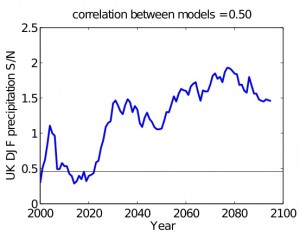Climate models produce projections of changes in climate from the present day, but these projections have a range, or spread. A simple measure of the confidence in a forecast would be the signal-to-noise ratio, r, of the size of the projected change to the spread around that change. An important question is ‘when does the spread in the forecasts become so large that the forecast should not be used’?
The answer to this question will depend on many aspects – including the number of projections available, and how independent they are. Steve Jewson and I have written a series of discussion papers on these issues.
Between using and not-using a forecast there is also likely to be a ‘middle-ground’ where the forecast could be ‘damped’ to reduce the expected error. Another critical consideration in answering whether we should use a forecast is how independent the predictions are.
There is now evidence that the GCMs used in the IPCC AR4 were not statistically independent (e.g. Knutti et al.). Accounting for correlation between models causes an inflation in model spread, which lowers the ratio, r, and makes the forecast less likely to be useful (see figure below).
We have also considered some Monte-Carlo and Bayesian methods to find the critical signal-to-noise ratio at which the forecast should be ignored, and how this depends on the number of predictions and the correlation between models. For example, different methods suggest the critical value of r is between 0.5 and 0.75 for an ensemble of 10 predictions.
